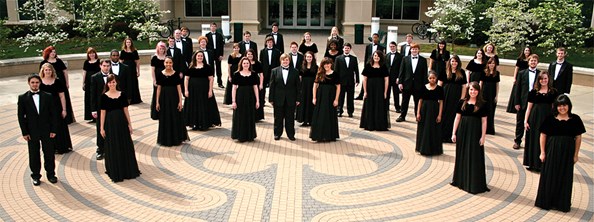Alumni Resources
About the University
The Evolution of Music at USI
by Trista Lutgring
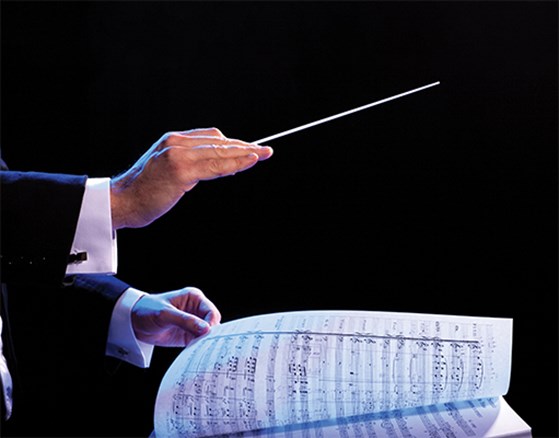
In 1969, a still very young University of Southern Indiana had students begging for more—activities, entertainment … something outside the classroom to occupy their minds and time.
Hope was ignited at the beginning of the Fall Semester that year, when University administration hired on David Deeg as an instructor of music, who declared, “We need more entertainment here.” Students rallied behind him quickly.
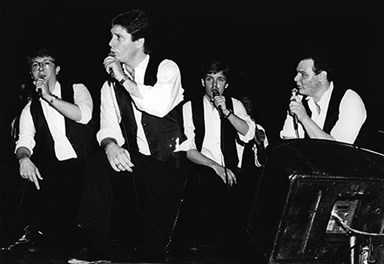
What Deeg and students may not have imagined—and what officials may not have realized at the time—was their determination would fuel those who followed, ignite future instructors to push for a more robust music program and open the door for donors to provide the necessary means to lead USI to a future with even more musical offerings.
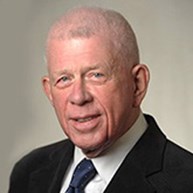 In October 2021, those offerings sprouted when award-winning composer and Posey County native Philip Hagemann provided a $2 million leadership gift to the University. Through this generous gift, USI established a fund to support and develop music programs at the University. Not only will the funds help current music ensembles and courses on campus, but it also bolsters the long-range vision of a full degree within USI's renamed Philip Hagemann Performing Arts Department. “Music must be part of a truly educated person’s study,” says Hagemann. “I am happy to assist in that endeavor.”
In October 2021, those offerings sprouted when award-winning composer and Posey County native Philip Hagemann provided a $2 million leadership gift to the University. Through this generous gift, USI established a fund to support and develop music programs at the University. Not only will the funds help current music ensembles and courses on campus, but it also bolsters the long-range vision of a full degree within USI's renamed Philip Hagemann Performing Arts Department. “Music must be part of a truly educated person’s study,” says Hagemann. “I am happy to assist in that endeavor.”
As other institutions across the nation look at cutting music programs and education, USI is at the beginning of an exciting chapter, fostered by dedicated University instructors, students with a passion for the arts and community members who have seen the importance of music in higher education.
A Historic Orchestrated Effort
When USI was a fledgling university and students were clamoring for music shows, Deeg secured a sponsorship from Beta Sigma Epsilon (business fraternity) to have the folk singers Ric and Lee perform. For two nights, the duo drew excited crowds—mostly students—for shows with music and humor.
No other proof was needed—USI students wanted musical arts as a part of their university experience, and the Mid-America Singers was formed. “Deeg created (the group) and patterned it off the Singing Hoosiers (at Indiana University),” says Dan Craig, Associate Professor of Music and Director of the USI Chamber Choir and Women’s Choir.
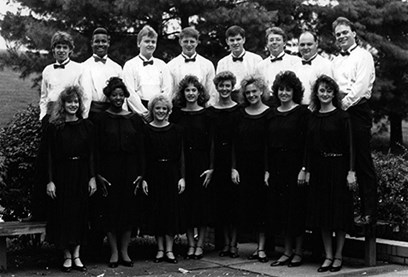 The Mid-America Singers was a dynamic force across the Tri-state; they not only acted as ambassadors of the University but were a popular entertainment provider in the Evansville community. The group sang, jammed, rocked and danced for crowds on and off campus. According to Craig, if there was an event in Evansville or on campus, the Mid-America Singers were there. “There was a time when they were making up to 30 or more appearances a semester,” he says.
The Mid-America Singers was a dynamic force across the Tri-state; they not only acted as ambassadors of the University but were a popular entertainment provider in the Evansville community. The group sang, jammed, rocked and danced for crowds on and off campus. According to Craig, if there was an event in Evansville or on campus, the Mid-America Singers were there. “There was a time when they were making up to 30 or more appearances a semester,” he says.
Though Connie Romain '74 came to the campus to pursue a degree in education, her higher-ed experience was shaped not only by her course work. As a longtime lover of musicals and a singer, Romain found a spot with the Mid-America Singers and Band which greatly influenced her time at the University. “I just can’t even tell you what a wonderful time in my life it was. We learned a lot from David Deeg...about performing and singing properly. It was a learning experience as well as a fun time.”
To expand the University’s musical entertainment events, Deeg proposed the creation of a 16th century English Christmas dinner—a Renaissance madrigal. “The Mid- America Singers, costumed in elegant 16th century robes, will provide the entertainment for this gala event,” he was quoted as saying in an internal newsletter. “And the dinner will be served in the pageantry that surrounded the English feast.”
Donning Renaissance period costumes, the Mid-America Singers and Band danced, sang and played in the Forum building (also known as the Tub) to the delight of the audience who packed the place. The feast for the event was personally cooked and served by USI's First Lady Betty Rice. “The Rices believed this was an opportunity to bring the community out to USI for fellowship,” says Craig. And the community agreed, by traveling to the University campus in support of the musical group.
Romain, who was a part of that first feast on campus, recalls around 75 people attending the first event. “It was so exciting,” she says. “Betty made [plum] pudding, the roast beef and everything. She was amazing.”
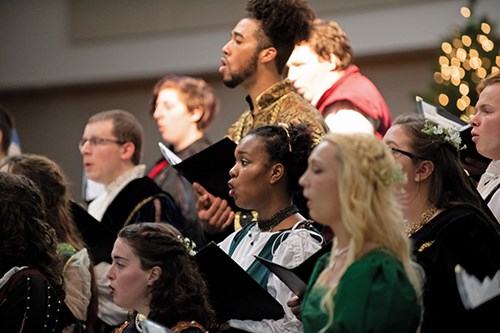 The event resulted in the formation of a tradition at USI’s campus that has continued for more than 50 years, growing from one to four performances during the holiday season. Audiences are seated in Carter Hall, served a dinner fit for royalty crafted by University Dining Services. Members of the University’s Chamber Choir perform selections of old English and Irish Madrigals, along with folk songs and other holiday choral selections to ring in the festive season.
The event resulted in the formation of a tradition at USI’s campus that has continued for more than 50 years, growing from one to four performances during the holiday season. Audiences are seated in Carter Hall, served a dinner fit for royalty crafted by University Dining Services. Members of the University’s Chamber Choir perform selections of old English and Irish Madrigals, along with folk songs and other holiday choral selections to ring in the festive season.
The Mid-America Singers were a strong fixture on campus and around the community for more than 30 years and gained national attention when they performed “An Elizabethan Christmas Celebration” on PBS television in 1977.
John Schutz ’82, business administration, joined the Singers upon coming to USI to keep music a part of his higher education. “It was something I enjoyed, and I had a fairly good skill at doing it at that point in time," he says. One of the biggest performances for the group during Schutz’s time was at Disney World. “We all drove down there in buses and performed out on their patio area,” he says. “We had a good time.”
Moving Forward
In 1995, Craig injected a dose of excitement into the music program. Building off connections he formed during a trip to Poland with the late Larry Goss, Professor Emeritus of Engineering Technology, Craig was able to take the Mid-America Singers to visit Poland for a European tour. “That was a big deal. We went and spent two weeks performing concerts all over Poland,” he says.
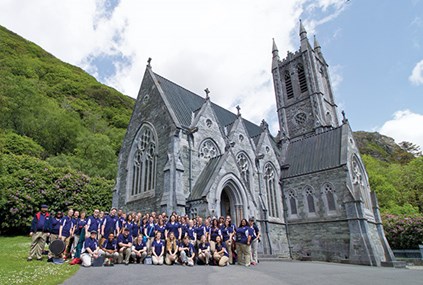 That first international trip led to others in following years—with each performance, each trip, Craig and others in the music program recognized there was a crescendo happening, a building moment where USI could go beyond the handful of classes and music groups that were available for students. “We’d taken the program about as far as it could possibly go," says Craig. "But we knew what we could do.”
That first international trip led to others in following years—with each performance, each trip, Craig and others in the music program recognized there was a crescendo happening, a building moment where USI could go beyond the handful of classes and music groups that were available for students. “We’d taken the program about as far as it could possibly go," says Craig. "But we knew what we could do.”
USI's Chamber Choir, a combination of the Mid-American Singers and Band (dissolved in 2001) and the Madrigal Singers Show Choir, became the University's sole mixed-voiced ensemble group. Students involved in Chamber Choir come from all disciplines across USI’s campus, and these students carry on the long tradition of the Madrigal Feaste. Like the Mid- America Singers before them, the Chamber Choir also stages performances for civic events and corporate parties in the Tri-state region.
The USI Women's Choir and USI Jazz Ensemble were also formed at this time. By the 2010s, it became obvious to those in the music program that it had reached a pivotal point. It was time to push forward even more. Of course, to accomplish this, there had to be support—not just on the University administration and student level.
Over the years, there were several major gifts from community members that played a large part in growth. These Evansville citizens, alumni and friends proved through their giving that music was important to the make-up of the USI campus.
The Dr. William C.H. and Phyllis R. Grimm Choral Music Endowment, provided by Phyllis Grimm in 2011, became an integral part of supporting the operations of the choirs and the continued forward momentum of the music program. Over the years, students have also been aided with scholarships and other endowments thanks to the generosity of the William E. Schmidt Music Scholarship; Thomas E. Topper MD Music Program; Deborah J. and Loretta M. Zygmunt Music Scholarship Endowment; Connie Romain Music/Theatre Scholarship Endowment and David V. Deeg Memorial Music Scholarship— all given to USI after seeing and hearing what the musical groups and courses were allowing students to accomplish.
These gifts paved the way for an addition of a keyboard lab in the Liberal Arts Center, where students could learn piano, and that keyboard lab morphed into an expansion of offerings never seen at USI before. “We knew [the keyboard lab would allow us to] add applied voice, which is vocal lessons,” says Craig.
Voice instructors were hired—Dr. Jackline Madegwa and Dr. Cheruvathur “Joe” Uthup—to help with the new voice minor disciplines, as well as Thomas Drury for the Jazz Ensemble and foundation courses. Along with music theory and piano, aural skills were added to the coursework of music program students.
A portion of the leadership gift from Genevieve B. Bootz in 2013 was used to purchase a Steinway Grand piano for the USI Performance Center. This served as the catalyst for the USI Foundation to fund six Wenger soundproof practice rooms, each with an upright Steinway/Boston piano where students can practice in privacy; the pianos were delivered to campus in April 2019. John Lawrence ’73 and Randy Haaff ’84 each generously provided underwriting for a piano.
The next steps to bringing music major programs to campus came with Hagemann’s generous $2 million gift last fall. “With the help of the Foundation and the generosity and those who have come before, Philip Hagemann and (his long-time friend) Dr. Murray Rosenthal, we have been given a leadership gift that will allow us to lay the foundation for major programs in music,” Craig says.
Hagemann, born and raised in Mount Vernon, Indiana, is an accomplished musician, teacher, producer and award-winning composer of two full-length operas, 10 one-act operas and 75 choral works, with an honorary Doctor of Humanities degree from USI, awarded in 2016.
“Music has been an integral part of my life since my youth,” Hagemann said, when the gift was announced. “With hard work and attention to detail I achieved success and want others to share in that success. What better place than the University built ‘by the people and for the people’ a scant 12 miles from my hometown.”
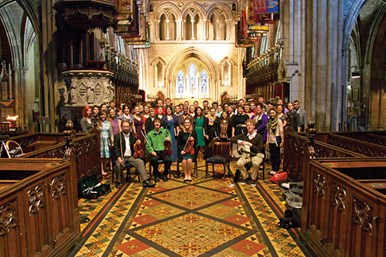 Craig says, in keeping with the University's focus on enhancing academic distinctiveness, the vision isn’t just for one music major, but five majors in total: applied vocal music/education; music business; music therapy; music and sound production; applied instrumental music/education. At a time when other higher education music programs are seeing cuts and possible removal of curriculum, USI is firmly showing a dedication to growing musical arts on campus.
Craig says, in keeping with the University's focus on enhancing academic distinctiveness, the vision isn’t just for one music major, but five majors in total: applied vocal music/education; music business; music therapy; music and sound production; applied instrumental music/education. At a time when other higher education music programs are seeing cuts and possible removal of curriculum, USI is firmly showing a dedication to growing musical arts on campus.
The Hagemann gift will allow USI to renovate existing spaces to teach applied voice and instrumental music, and to expand the instrumental music offerings currently on campus. The funds will help with recruiting purposes, for equipment and infrastructure purposes and for the maintenance of the Philip Hagemann Award for Musical Performance, which goes to high school juniors and seniors in Posey County.
And just as USI’s musical groups have been an integral part of establishing the music programs and minors existing on campus today, they will continue that support as the majors in music begin to take shape. “We are here primarily to teach and if you’re interested in music, why should you not have an opportunity to perform?” says Craig. “Our ensembles, even our audition ensembles, are going to be open to the entire University community. They play a huge part in the vision of the new programs. They stand as the visual and aural identity of the new department.”
With the plan laid out, that identity looks to grow into something Craig and others in the program and across the University hope to see recognized on a national level. With USI’s history of offering a solid, recognized education, Craig sees this direction for music at USI furthering that mission. “As we build our resources to hire faculty and increase programs, we are going to be able to stand toe-to-toe with other universities,” he says. “This leadership gift, along with all those which have come before, will one day be recognized as the seeds which ultimately produced a full-fledged music program.”
